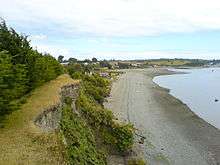Biogeomorphology

Biogeomorphology and ecogeomorphology are the study of interactions between organisms and the development of landforms, and are thus fields of study within geomorphology and ichnology. Organisms affect geomorphic processes in a variety of ways. For example, trees can reduce landslide potential where their roots penetrate to underlying rock, plants and their litter inhibit soil erosion, biochemicals produced by plants accelerate the chemical weathering of bedrock and regolith, and marine animals cause the bioerosion of coral. The study of the interactions between marine biota and coastal landform processes is called coastal biogeomorphology.
Phytogeomorphology is an aspect of biogeomorphology that deals with the narrower subject of how terrain affects plant growth.[1] In recent years a large number of articles have appeared in the literature dealing with how terrain attributes affect crop growth and yield in farm fields, and while they don't use the term phytogeomorphology the dependencies are the same. Precision agriculture models where crop variability is at least partially defined by terrain attributes can be considered as phytogeomorphological precision agriculture.[2]
Origins and Early Work
The earliest work related to biogeomorphology was Charles Darwin's 1881 book titled The Formation of Vegetable Mould, Through the Action of Worms, with Observations on their Habits.[3][4] Although the field of biogeomorphology hadn't yet been named, Darwin's work represents the earliest examination of a faunal organism influencing landscape process and form.[4] Charles Darwin begins his work on worms with an examination of behavior and physiology, which then moves towards topics related to geomorphology, pedogenesis, and bioturbation.[3][4] Observations and measurements of soil moved by earthworms, and emphasis on the role of earthworms in formation of humus, fertility of soils, and mixing of soils were all described in the book, which began to change the perspective on earthworms from pest to critical agent of pedogenesis.[3][5] Despite the popularity of Darwin's final work, the scientific community was slow to recognize the significance of examining the role of organisms in influencing landscapes.[5][6]
It wasn't until the late twentieth century that biogeomorphology began attracting the attention of more than a handful of researchers.[6]
See also
References
- ↑ Howard, J.A., Mitchell, C.W., 1985. Phytogeomorphology. Wiley.
- ↑ Reuter, H.I., Giebel, A., Wendroth, O., 2005. Can Landform Stratification Improve Our Understanding of Crop Yield Variability. Precision Agriculture, 6, 521-537.
- 1 2 3 4 Darwin, C. 1881. "The Formation of Vegetable Mould, Through the Action of Worms, with Observations on their Habits." London: John Murray.
- 1 2 3 Tsikalas, S.G., Whitesides, C.J. 2013. Worm geomorphology: lessons from Darwin. "Progress in Physical Geography" 37(2):270-281.
- 1 2 Meysman, F.J.R., Middelburg, J.J., Heip, C.H.R. 2006. Bioturbation: a fresh look at Darwin's last idea. "Trends in Ecology and Evolution" 21(12): 688-695.
- 1 2 Butler, D.R., Hupp, C.R. 2013. The role of biota in geomorphology: ecogeomorphology. Ed. Shroder, J.F. Treatise on Geomorphology, Volume 12. Elsevier: London.
Bibliography
- Viles, Heather (1988). Biogeomorphology. Oxford: Basil Blackwell. ISBN 0-631-15405-1.
- Hupp (1995). Biogeomorphology, Terrestrial and Freshwater Systems. ISBN 0-444-81867-7.
- Osterkamp, W.R.; Friedman, J.M. (1997). "Research Considerations for Biogeomorphology". Proceedings of the U.S. Geological Survey (USGS) Sediment Workshop 'Expanding Sediment Research Capabilities in Today's USGS'. Reston, VA, and Harpers Ferry, WV. Retrieved 2007-06-15.